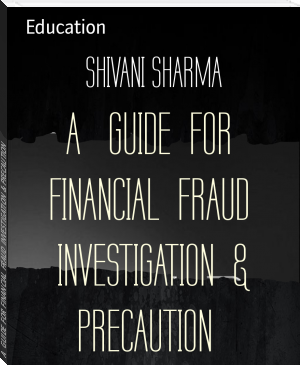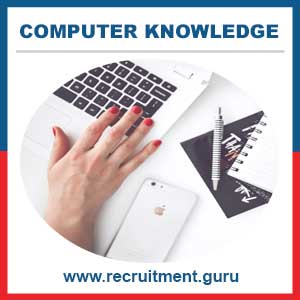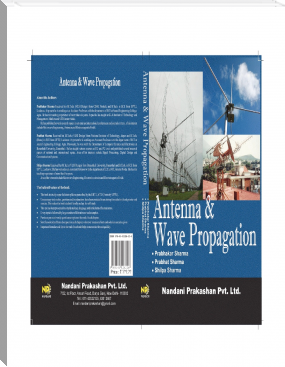A GUIDE FOR FINANCIAL FRAUD INVESTIGATION & PRECAUTION by SHIVANI SHARMA (thriller books to read txt) 📖

- Author: SHIVANI SHARMA
Book online «A GUIDE FOR FINANCIAL FRAUD INVESTIGATION & PRECAUTION by SHIVANI SHARMA (thriller books to read txt) 📖». Author SHIVANI SHARMA
In a related case, the SEC said Rezakhani made $115,997 trading Amazon shares based on the tip from Kennedy.
Legal Insider TradingThe term "insider trading" is generally negative. Legal insider trading happens in the stock market on a weekly basis. The SEC requires transactions to be submitted electronically in a timely manner. Transactions are submitted electronically to the SEC and also must be disclosed on the company’s website.
The Securities Exchange Act of 1934 was the first step to the legal disclosure of transactions of company stock. Directors and major owners of stock must disclose their stakes, transactions and change of ownership. Form 3 is used as an initial filing to show a stake in the company. Form 4 is used to disclose a transaction of company stock within two days of the purchase or sale. Form 5 is used to declare earlier transactions or those that have been deferred.
INDEX - IIII
COMPUTER KNOWLEDGE AND CYBER CRIME AND SECURITY
TOPIC SUBJECT BASIC KNOWLEDGE COMPUTER KNOWLEDGE ALL THE SHORT CUT KEYS COMPUTER KNOWLEDGE Basic of Excel COMPUTER KNOWLEDGE CYBERCRIME AND THE LAW CYBERCRIME The 16 Most Common Types of Cybercrime Acts CYBERCRIME Phishing CYBERCRIME Hacking Cybercrime Identity Theft CYBERCRIME Pornography CYBERCRIME Child Pornography CYBERCRIME Software Piracy CYBERCRIME Hacking CYBERCRIME Social engineering CYBERCRIME Basic Knowledge of Computer
Computer: A Computer is a General purpose machine, commonly consisting of digital circuitry, that accepts (inputs), stores, manipulates, and generates (outputs) data as numbers, text, graphics, voice, video files, or electrical signals, in accordance with instructions called a program.

Full form of Computer:
C – Commonly O – Operated M – Machine P – Particularly U – Used for T – Technical E-Education R – ResearchCharacteristics of Computer
Speed Accuracy Storage Diligence Versatility AutomationComputer – An Introduction
A computer is a device that can receive process and store data. However, all computers have several parts in common: Input devices allow data and commands to the computer (Mouse, Keyboard etc.) Memory for storing commands and data. Central Processing Unit which controls the processing. Monitor Process the information in the form of output.Types of computers
Computers range in size and capability. There are supercomputers, very large computers with thousands of microprocessors that perform extremely complex calculations.
There are tiny computers embedded in cars, TVs, stereo systems, calculators, and appliances. These computers are built to perform a few number of tasks.
Desktop computers
Desktop computers design is made for use at a desk or table. They are typically larger and more powerful than other types of personal computers. The main component, called the system unit, is usually a rectangular case that sits on or underneath a desk. Other components, such as the monitor, mouse, and keyboard, connect to the system unit.Laptops
The Laptops are lightweight mobile PCs with a thin screen. Laptops can operate on batteries, so you can take them anywhere. Unlike desktops, laptops combine the CPU, screen, and keyboard in a single case. The screen folds down onto the keyboard when not in use.Handheld computers (PDA)
Handheld computers, also known as personal digital assistants (PDAs), are battery-power computers small enough to carry almost anywhere. These are useful for scheduling appointments, storing addresses and phone numbers, and playing games. Some have advanced capabilities, such as making telephone calls or accessing the Internet. Instead of keyboards, handheld computers have touch screens that you use with your finger.Peripheral Devices
The peripheral device connects to a computer system to add functionality. Examples are a mouse, keyboard, monitor, printer and scanner. A computer peripheral is a device that connects to a computer but is not part of the core computer architecture. The core elements of a computer are the central processing unit, power supply, motherboard and the computer case that contains those three components.Types of Peripheral Devices
There are many peripheral devices, but they fall into three general categories: Input devices, such as a mouse and a keyboard Output devices, such as a monitor and a printer Storage devices, such as a hard drive or flash driveComputer Knowledge – Main Parts of Computer
Hardware
Computer hardware is what you can physically touch includes the computer case, monitor, keyboard, and mouse. It also includes all the parts inside the computer case, such as the hard disk drive, motherboard, video card, and many others.Input Devices
In computing, an input device is a peripheral (piece of computer hardware equipment) used to provide data and control signals to an information processing system. It will control devices such as a computer or information appliance.Examples: keyboards, mice, scanners, digital cameras and joysticks.
Keyboard
A Keyboard is the most fundamental input device for any computer system. It helps to enter data on the computer.Mouse
A mouse is used to input data by sending a signal to the computer, based on hovering the cursor and selecting with the left mouse button. The left mouse acts as an ‘enter’ button. The right mouse button can be selected and will often pop up a window of choices. The scrolling wheel is used to move the view of the screen up or down. By moving your mouse to a location in a document, on a digital photo or over a choice of music, you can click the left mouse button to place the cursor.Trackballs
A trackball is an input device used to enter motion data into computers or other electronic devices. It serves the same purpose as a mouse but is designed with a moveable ball on the top, which can be rolled in any direction. Instead of moving the whole device, you simply roll the moveable ball on top of the trackball unit with your hand to generate motion input.Basic Knowledge of Computer – Main Parts of Computer
Barcode reader
A barcode reader (or barcode scanner) is an electronic device that can read and output printed barcodes to a computer. Like a flatbed scanner, it consists of a light source, a lens and a light sensor translating optical impulses into electrical ones.Digital camera
A camera which produces digital images that can be stored in a computer and displayed on the screen.Gamepad
The gamepad is a handheld controller for video games.Joystick
The joystick is a lever that can be moved in several directions to control the movement of an image on a computer or similar display screen. It mainly used in playing games.Microphone
Micro Phone is an instrument for converting sound waves into electrical energy variations which may then be amplified, transmitted, or recorded.Scanner
The scanner is a device that scans documents and converts them into digital data.Webcam
A webcam is a video camera connected to a computer, allowing its images to be seen by Internet users.Optical character recognition (OCR)
Optical character recognition is the mechanical or electronic conversion of images of typed, handwritten or printed text into machine-encoded text.Digitizer
It converts analogue information into digital form.Optical Mark Reading (OMR)
Optical Mark Readers reads pencil or pen marks made in pre-defined positions on paper forms as responses to questions or tick list prompts.Structure of CPU – Computer Knowledge Basics

Input and Output devicesInput Devices – Computer Knowledge
An input device feeds data to the computer system for processing.
We are going to discuss the most commonly used input devices in this article.
Keyboard
The computer keyboard is to enter text information into the computer. The main use of the keyboard is to type commands directing the computer to perform certain actions.Mouse
A device that controls the movement of the cursor or pointer on a display screen. A mouse is a small object you can roll along a hard, flat surface. The invention of the mouse is made by Douglas Engelbart of Stanford Research Center in 1963.Joystick
Joysticks and similar game controllers can also be connected to a computer as pointing devicesScanner
A scanner is a device that images a printed page or graphics by digitizing it, producing an image made of tiny pixels of different brightness and colour values which are represented numerically and sent to the computer. Scanners not only scan graphics, but they can also scan pages of text.MIDI Devices
MIDI (Musical Instrument Digital Interface) is a system design to transmit information between electronic musical instruments.Trackball
The trackball is sort of like an upside-down mouse, with the ball located on top. You use your fingers to roll the trackball, and internal rollers (similar to what’s inside a mouse) sense the motion which is transmitted to the computer. Trackballs have the advantage over mice in that the body of the trackball remains stationary on your desk.Graphics Tablet
A graphics tablet consists of an electronic writing area and a special “pen” that works with it. A graphics tablet allows creating graphical images with motions and actions.Computer Knowledge – Output Devices
Monitor
Monitors, commonly called as Visual Display Unit (VDU), are the main output device of a computer. It forms images from tiny dots, known as pixels that make an arrangement in a form of a rectangular form. The sharpness of the image depends upon the number of pixels.Printers
The printer is an output device, which is to print information on paper.
There are two types of printers:
Impact Printers Non-Impact PrintersPlotters
A plotter is a printer that interprets commands from a computer to make line drawings on paper with one or more automated pens. Unlike a regular printer, the plotter can draw continuous point-to-point lines directly from vector graphics files or commands.Projector
A projector or image projector is an optical device, which projects an image (or moving images) onto a surface, commonly a projection screen.Speakers
Speakers are one of the most common output devices with computer systems. Some speakers are designed for work specifically with computers, while others can be hooked up to any type of sound system.Memory
Memory is the storage space in the computer where data get the process and instructions required for processing get store. The memory is split into a large number of small parts known as cells. Each location or cell has a unique address which varies from zero to memory
 The desire to acquire knowledge about the surrounding world and human society is quite natural and understandable for a person. Life is so developed that an uneducated person will never occupy a high position in any field. Humanity in its mass, and each person individually, develops objectively, regardless of certain life circumstances and obstacles, but with different intensity. The speed of development depends on the quality of training.
The desire to acquire knowledge about the surrounding world and human society is quite natural and understandable for a person. Life is so developed that an uneducated person will never occupy a high position in any field. Humanity in its mass, and each person individually, develops objectively, regardless of certain life circumstances and obstacles, but with different intensity. The speed of development depends on the quality of training.




Comments (0)